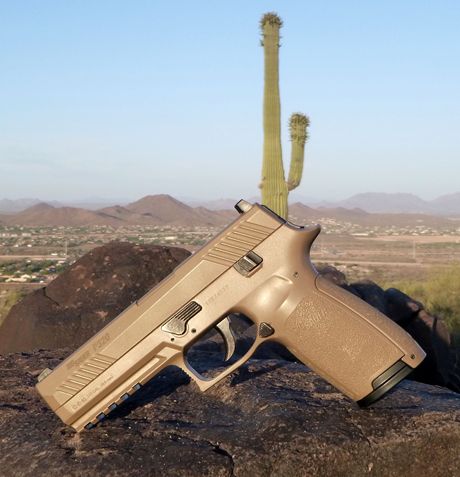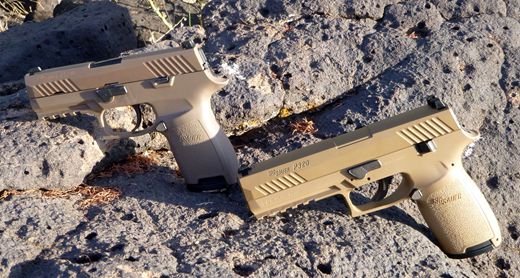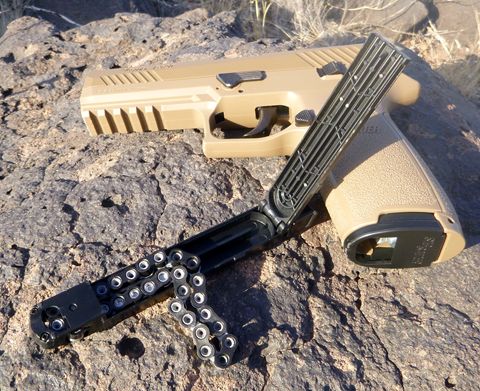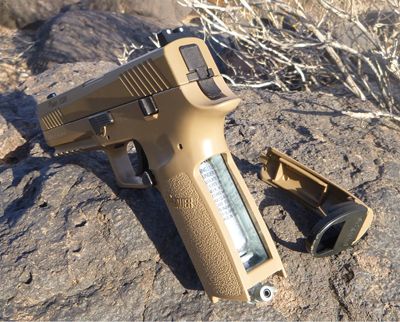If you are thinking that I’ve caught some sort of a SIGness, you may be
right. Behold … Sig Sauer P320 number three! But as you can surmise
from the title, this one does not burn powder, but relies on good old
CO2 cartridges for thrust.
It is a genuine SIG, not a licensed copy, though it’s not made in New
Hampshire, but in Japan. But it is designed, spec’d, and sold exclusively
by the guys at SIG Sauer, Inc.
It is a .177 caliber pellet or BB shooter with, get this … a 30 shot chain
link magazine! Now that is different. It is meant to be a training pistol,
as it is dimensionally accurate in every way to a full size P320. It also
weighs the same as the real thing. The trigger pull is a bit longer and
heavier, but the slide even reciprocates with every shot, to give a little
of the flavor of genuine recoil. Of course it fits perfectly in any holster
designed for a P320.
The CO2 P320 comes either in black or “Coyote Tan”. Below, here it is next
to the real thing, a P320 Compact FDE. As you can see, the Japanese
manufacturer wasn’t quite able to match the firearm’s FDE color, so they
just called it something different, I guess.
From a realism standpoint, about the only thing that could have been better
is the simulated barrel breech block in the slide. It is just a depression
that they didn’t bother painting black. It’s Coyote Tan, like the rest of
the slide. Sooner or later, I’ll get around to masking the rest of the gun,
and hitting that depression with a quick shot of black spray paint.
The takedown lever is black, but it’s a non-moving dummy. It doesn’t do
anything. You can’t do any grip swapping with the CO2 gun like you can with
the powder burners. It is what it is. You cannot take the CO2 pistol apart
for field stripping.
Another in-authenticity is that the “slide release” is not, but it’s a safety
button that moves back and forth. The safety operates a little weirdly. When
engaged, you can still pull the trigger through. The magazine will index the
next shot, and the gun will go click – every time. But what does not happen,
is the release of CO2 gas. That’s all that the safety does – prevents the gas
from discharging, hence the gun does not fire.
The magazine release operates exactly how you would expect – it drops the
magazine cleanly, just like the regular P320. The difference is in the magazine
itself, which is a long skinny thing.
About that magazine – the chain links I mentioned are something like a plastic
bicycle chain. The first part of the trigger pull moves the chain to bring the
next pellet in-line with the barrel. Strangely, the extra magazines that you
can buy are only 20 rounds. The 30 round magazine is only available with the
gun. One CO2 cartridge is good for around 60 shots, or two full 30-round
magazines.
That you cannot take the gun apart turns out to be a small problem. Sometimes,
a pellet can jam in the magazine. That happens when a pellet moves out of
position within the magazine belt, sticking perhaps halfway out of the pellet
recess within the link. When that happens, pulling the trigger cannot advance
the magazine belt, thus you cannot complete the trigger stroke. This has
happened to me a couple of times when using low-quality pellets, left over from
who-knows-where. The fix is to push some sort of a rod or wire, of diameter
less than .177, down the barrel from the muzzle, to push the errant pellet back
into place within its recess in the magazine link.
Loading the magazine is a little time consuming. Grabbing a pellet from a pellet
tin, making sure that it is oriented correctly, and pressing it into a link
recess, 30 times, gets a bit tedious.
As you can see in the photo above, when the magazine is removed from the
gun, what would be the basepad of the real firearm’s magazine stays with the gun.
But actually that can be removed as well, by simply pulling down. The basepad and
the backstrap come off as a single unit. This reveals the CO2 cartridge recess.
The basepad/backstrap can be removed with either the magazine in-place or removed.
As far as accuracy in concerned, it is not even close to the accuracy of the Gamo
PR-45 single-stroke pneumatic that I wrote about for the March issue of the
newsletter. But that’s OK. The Gamo does not keep shooting and shooting with
every stroke of the trigger like this SIG does. It is just a fundamentally
different kind of animal, fun to shoot in its own way. It is still capable of
knocking over cans at 10 to 15 yards for plinking fun like the Gamo. It just may
take a few more shots to do it.
And because the CO2 cartridges are expendables, it ends up costing more to shoot
than the Gamo which only requires muscle power to recharge. If you buy them in
bulk, the gas cartridges can be less than a buck each, which is not too bad.
I was able to get this gun for “free” with saved up credit card points. Cost was
about $100. As a new SIG fanboy, I couldn’t resist.

![]()






